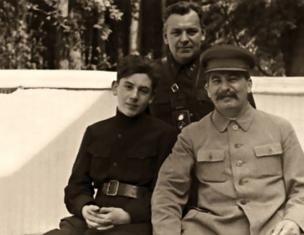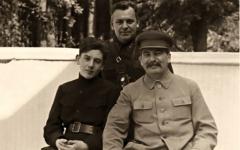Great Patriotic War Date August 3 September 15, 1943 Place Belarusian SSR, Leningrad Region ... Wikipedia
Great Patriotic War Date September November 1943 Place Belarusian SSR, Leningrad Region, Kalininskaya Oblast ... Wikipedia
The "Concert" operation code name of the operation of the Soviet partisans conducted from September 19 to the end of October 1943, the continuation of the operation "Rail War". Contents 1 Geography Operations 2 Operation Operation 3 Preparation ... Wikipedia
- "Concert", the name of the operation of the Soviet partisans 19.9 The end of October 1943 during the Great Patriotic War in terms of the conclusion of the enemy's railway communications in the occupied territory of Belarus, Karelia, Lithuania, Latvia, Estonia, ... ... encyclopedic Dictionary
Operation "Happy New Year", Russia, STV / Nikola Film, 1996, CV., 93 min. New Year's comedy. The film "Operation" Happy New Year! " Disappointed many fans of "National Hunting Features". And in fact: on the site of the burlesk comedy with strong ... ... Encyclopedia of cinema
I concert (it. Konzert, from Ital. Concerto concert, harmony, consent, from Lat. Concerto compete) a musical work, in which a smaller part of the participating instruments or votes opposes their greater part or the entire ensemble, ... ... Great Soviet Encyclopedia
The importance of the subject of the article is questioned. Please show the importance of its subject in the article by adding evidence of importance on private importance criteria or, if private criteria for significance for ... ... Wikipedia
Great Patriotic War Date August 26, 1943 September 30, 1943 ... Wikipedia
Soviet partisans in Belarus, 1943 Soviet partisans An integral part of the anti-fascist resistance movement [clarify], which fought by the methods of partisan wars ... Wikipedia
Books
- Road to Berlin. "From victory to victory", Isaev Alexey Valerevich. The night of January 12, 1945. The Red Army is ready to go to the decisive attack on the taste. The noise of motors in the last rearrangements on the Sandomira bridgehead is masked by loud music through ...
- The road to Berlin from victory to victory, Isaev a .. Night for January 12, 1945. The Red Army is ready to go to the decisive attack on the taste. The noise of motors in the last rearrangements on the Sandomira bridgehead is masked by loud music through ...
Military Historical Library
Home Encyclopedia War History Read more
Partisan operation "Concert"
1943 entered the history of the partisan struggle as a year of massive blows on railway communications of the German fascist troops. The partisans actively participated in major operations on enemy communications - "Rail war" and "Concert". "Concert" is the conditional name of the operation conducted during the Great Patriotic War by Soviet partisans from September 19 to the end of October 1943.
The positive results of the "Rail War" operation gave the basis for the development of subsequent operations of a similar type. In early September 1943, the head (CSTP) at the expense of the Supreme Commander Approved the plan for the destruction of the enemy railway tracks (the operation "Concert"). Each partisan formation received a specific combat task, including the undermining of rails, the organization of brushes of military echelons of the enemy, the destruction of road structures, the conclusion of means of communication, water supply systems, etc. Detailed combat plans have been developed and mass training guerrilla has been established by the production of subversive work.
 Head of the Central Staff of the Partisan Movement at the bid of the Supreme Command lieutenant-general PC. Ponomarenko |
The purpose of the operation is a massive conclusion of large areas of railways in the rear of the Eastern Front of the German-Fascist troops from Karelia to Crimea make it difficult for the operational transportation of troops, military equipment and other material means of the enemy. Being a continuation of the operation "Rail War", the "Concert" operation was conducted under the leadership of CCTP and was closely connected with the upcoming onset of Soviet troops at Smolensk and Gomel directions and during the battle for the Dnieper. 193 partisan formations of Belarus, Baltic States, Karelia, Crimea, Leningrad, Kalininskaya, Smolensk and Oryol regions with a total number of 120,615 people who had to undermine more than 272 thousand rails were attracted to participation in the operation. About 92 thousand partisans participated in Belarus; They had to undermine 140 thousand rails. The central headquarters of the partisan movement intended to abandon the Belarusian partisans of 120 tons of explosives and other goods, Kalininsky and Leningrad partisans - 20 tons. |
Due to the sharp deterioration of meteorological conditions, only about half of the planned amount of goods were transferred to the beginning of the operation, therefore mass sabotage was decided on September 25. However, part of the detachments that have already published on the original frontiers could not take into account changes in the periods of operation and on the night of September 19, when the Red Army, the liberty of the Oryol, Smolensk region and the Left-Bank Ukraine, approached the Dnieper, began to implement it. Only the partisans of Belarus on the night of September 19 undermined 19,903 rails.

The partisans of the detachment "Folk Avenger" Temkinsky district mining the railway canvas. Smolensk region. September 1943
Already at 6 o'clock in the morning, the Directorate of German State Railways in Minsk was alarming: "The situation is very tense! Actions Partisans are unbearably increasing. All nodal stations are overflow due to the impossibility of using lines ... ".
The bulk of partisan connections began fighting on the night of September 25. Defeating the protection of the enemy and traveled by railway distilts, they began massive destruction and mining of the railway canvas. Simultaneous actions on the plan of operation "Concert" were produced at the front of about 900 km (excluding Karelia and Crimea) and in a depth of over 400 km. Only on the territory of Belarus, another 15,809 rails were undermined on this night.
The German fascist command made desperate efforts to restore traffic on railways. The fascists in a hurried manner were moved from Germany and even from the front line new railway rehabilitation battalions, and the local population was drilled on repair work.

Partisans are preparing to minimize the railway canvas
Diversions on railways continued in October. Over 148,500 rails were undermined. At this, the operation "Concert" was actually discontinued due to the lack of supplies of explosives. Despite the fact that the tasks of the operation were not fully fulfilled, its results were significant. The roads that were not only in the East of the occupied territory were massive, which was in the "rail war", but also in the West of Belarus, in the Baltic States and Karelia.
The results of guerrilla operations on the mass undermining rails were very effective. Only during the first two operations ("Rail War" and "Concert") from July 22 to October 1943, 363,262 rails were undermined on railways in the enemy rear, which corresponded to 2270 km of a single railway track. Especially a lot was destroyed by rails in such sites, like Luninets - Kalinkovichi (41,781), Pskov - bottom (23 887), Polotsk - Molodechno (21 243), Leningrad - Pskov (17 659), Mogilev - Zhlobin (15 074), Krichev - Unecha (12 204), Orsha - Minsk (7982), Bryansk - Unecha (7031). The armed deficit in the rails of the Nazis was trying to fill in the fact that they changed the two-way areas of the path to uninterrupted, welded the interrupted rails and even imported them from Poland, Czechoslovakia and Germany. However, the partisans were dismissed repaired areas. It even more increased tensions in the work of the enemy railway transport. According to Colonel A.I. Brujanova, Head of the Operational Department of the Belarusian Staff of the Partisan Movement, only in August for this purpose, 5 thousand bio-axis platforms and hundreds of locomotives were used.
According to military specialists, the actions of partisans in the Operations "Rail War" and "Concert" were more than 11 times more than 11 times of all the raids of German-fascist aviation, which dropped about the same period on railways in the Soviet rear of more than 10 thousand aviation bombs .
And the outcome of the partisan operations of the type "Rail War" and "concert" was not only a huge number of converted rails. They included a large range of sabotage shares on all communications of the opponent - rail, motor vehicles, aquatic and air, supported by blows on garrisons and other important objects in the enemy rear.
Simultaneously with the subsection of rails, the partisans were allowed to sleep under the slopes, destroyed bridges, railway stations, were outdated by other elements of the travel economy. In the same period, as a result of the actions of the Ukrainian and Moldovan partisans, hundreds of collections of military echelons of the enemy occurred. The capacity of the opponent's railways in the occupied territory of the USSR in September-October 1943 as a result of the action partisans decreased significantly. According to some estimates, it decreased by 35-40%, which greatly made it difficult to regroup the fascist troops and had great help to the upcoming Red Army.
Ultimately, the transfer along the railway of parts and connections of the Wehrmacht, as well as the exercise of the enjoyment and evacuation was significantly difficult. The operation "Concert" has intensified the struggle of the Soviet people against the German-fascist invaders in the occupied territory. In the course of it intensified the influx of the local population in partisan formations.
Each new generation of Russian people will have their own point of view about the armed conflict, which will remain in the history and memory of both the Second World War (the Great Patriotic War). Such dates, as the beginning, and the end of this bloody and senseless fierce war will never erase the Russian person from memory. And one of the most important parts that have sought the victory of the fraternal peoples of the USSR over German-fascist invaders is the partisan movement.
In the territories occupied by the German troops, the fascists set the so-called new order. And this new mode has led to the mass and cruel resistance of the indigenous people of the occupied territories. Over all territories occupied by the enemy, the partisan and sabotage war have grown.
The struggle of guerrilla detachments and compounds on the captured by the German fascist troops became an integral part of the Great Patriotic War. The actions of the partisans on the captured territories oppressed morally and physically German troops, they felt that were in constant waiting for sabotage. And these sabotage were not fictional, but a real danger, because of them, the Germans had numerous human sacrifices and a huge loss of military equipment.
There are a lot of certificates of complaint and dangerous operations with the participation of the Soviet Army on the scale of the management of the partisan war. One of these operations has been held from August to September 1943 on the marks of Ukraine and Belarus captured by the enemy. The purpose of this operation was the destruction of the part of railway communications. The operation received the classified name "Rail War". Leningrad, Smolensk, Orlovsky partisans were involved in this operation.
The order at the start of the operation "The Rail War" was signed by CSTP (Central Headquarters of the Partizan Movement) on June 14, 1943. All areas falling under the actions of the CSTP operation shared between the partisan groups. Intelligence Partizan regularly monitored the objects on which the sabotage had to be conducted. The "Rail War" began from the second to the third of August and lasted almost until the end of September. Diversions and bars in the rear of the enemy turned around throughout the operation, and this is about one thousand eight hundred kilometers. The participants of the operation were almost one hundred thousand people, with the mass support of local residents.
Diverse strikes made by partisans by railways, railway bridges and stations were unexpected for Hitler's troops. After committing acts of sabotage, the fascist invaders could not have arisen and organize systematic and effective counter-partisan actions. During the operation, the "Rail War" operation was blown up a huge number of railway tracks (about two hundred fifteen thousand rails), bridges, and flew to the slopes of echelons with equipment and personnel. Also, diversions almost at forty percent reduced the frequency of movement of the echelons, which slowed down the movement of the Germans.
The operation "Concert" pursued similar purposes and was as it were for the second part of the operation "Rail War". It was necessary in a short period of time to destroy as many railway communications under the control of the Germans as possible, since the large-scale offensive of Soviet troops on the Dnieper was planned. More than one hundred ninety-three partisan groups and sabotage groups, and more than one hundred and twenty thousand people were involved in it. The operation "Concert" was started from September 19 to last until November 1, 1943. But due to the fact that the weather conditions have worsened the operation was decided to transfer to September 25. And the Soviet aviation elementary did not have time to smuggle all explosives, but transported only half. However, some of the sabotage groups have already moved to the point, and could not receive an order for transferring the start of the operation, and began sabotage from September 19.
On the night of September 24-25, at the same time was undermined by railway paths, bridges at a distance of nine hundred and kilometers. During the sabotage operation, there was a breakdown of about one thousand trains, undermined seventy bridges, was defeated by sixty making Germans. The operation had to be finished, due to the errors of the development of the operation itself, since the partisan groups ended the reserve of prepared explosives. The German-fascist invaders do not regret the forces, continuously, in a few shifts they conducted repair work, but still did not have time. You can also call one minus operation, this is the fact that the sabotage was subjected to the railway itself, which later slowed down the offensive of Soviet troops. Much more effective was the enemy's enemy's echelons themselves.
The tasks of the "Concert" operation were similar to the tasks of the "Rail War" operation, reduce the speed of movement of enemy echelons, and this goal was achieved. Partisan compounds perfectly completed the task of standing in front of them, and all flaws remained at the conscience of the staff bosses. That I had a post assistance in the defeat of the Hitler's occupiers in Ukraine, Belarus, Karelia and the Crimea.
This "concert" shown by Russian partisan compounds Hitler's troops could not yet erase from their memory.
The successful conduct of partisan divisions of the "Rail War" operation gave the basis for the development of subsequent campaigns for a similar scenario. In early September 1943, the central headquarters of the partisan movement began to develop and prepare for a new massive strike on the rear communications of German troops in the occupied territories under the codenate name "Concert".
The main task set in front of the partisans was the applied of the maximum damage of the German transport infrastructure, which in turn had to reduce the operational mobility of Reich's troops. The "Concert" operation was closely connected with the onset of Soviet troops in Smolensk and Gomel directions, as well as the release of the Red Army to the shores of the Dnieper and Desna rivers. The partisans had to strike in a huge area: on the front about 700 km and in the depth of over 400 km, covering the territory of Belarus, Ukraine, Baltic States, as well as the Leningrad and Smolensk regions. To attract to the operation was planned over 200 partisan compounds, a total number of about 150 thousand people.
When preparing for operation, not only the most carefully developed plans of the actions of each unit, but also a total training of fighters of partisan detachments of subversive work was carried out. For example, on the territory controlled by the Chernihiv-Volyn partisan compound, a whole polygon was built for training purposes, which was a 300-meter railway station equipped with all possible defensive structures. On this landfill, disperses and miners, machine gunners and mortars were honored around the clock. Over time, many fighters have become virtuosos of sabotage work.

Together with the railway infrastructure, the objects for sabotage were automotive highways, airfields, warehouses with flammable and ammunition. Partisans also had to paralyze the movement of enemy vehicles. The roads have become no less dangerous for the enemy.
As part of the preparation for the operation, Soviet aviation began to throw weapons and explosives for partisan brigades. The date of the "Concert" was chosen on September 19, 1943 - It was by this time that the advanced parts of the Red Army had to go to the Dnieper rivers, prong and gums and start their forcing. However, the weather intervened in the central headquarters' plans. Heavy meteorological conditions did not allow to deliver all the necessary partisans on time. The beginning of the operation was decided to postpone on September 25.

Partisan actions should not be limited exclusively by sabotage. The Ukrainian detachments, especially acting between the gums and Dnipro, were tasked with the seizure and recession and bridgeheads on the banks of the rivers. For these purposes, artillery and combat payments to it were reset in the partisan parts.
Partisan siversesies, both on railway and automotive highways were to paralyze the preparation of the counterattack of Hitler's troops in the Dnieper area.

From the memories of the former Hitler's general K.Tippelskirch: |
"The 2nd German army, starting from September 27, unsuccessfully tried to pull a sufficient amount of forces with the aim of blowing in the southern direction to restore the connection with the South Army Group between Pripyat and Dnipro, where in the meantime, increasingly large forces of Russians were concentrated. Nehbust and therefore, before the limit overloaded railway network, the bandwidth of which, already insignificant in the area of \u200b\u200bthe Pripyat marsh, was even more declining as a result of fierce activities of the partisans, it could hardly provide the import of all necessary for this army. The transfer of the allocated forces was carried out by a turtle rate that the nerve of the command was strained to the limit and forced it all the time to transfer the timing of the intended offensive, although the latter was becoming increasingly difficult every day. " |

The partisans of Belarus operated here
In the rear of German invaders, in the occupied areas of Belarus, folk avengers are bravely fighting with the enemy - Belarusian partisans, helping the upcoming Red Army. Particularly actively acted in Polesie. They set their goal - to destroy the communications of the enemy. Like neither the Germans guarded railways, what measures neither were taken to fight the partisans, everything was in vain! Railway bridges, paths, compositions, movement on the roads took place on the air, then it was suspended.
Now that the Red Army freed from German invaders a number of areas of Belarus, we saw the traces of the heroic struggle of folk avengers against the Nazis. Before you - a series of photodocuments showing the fighting work Polesia guerrilla: blown paths, brushed under the slopes of railway formulations, torn telephone and telegraph lines.
And Kalinin region
Operations Operations are achieved
| unknown | cm. |
Operation "Concert" - the code name of the operation of the Soviet partisans, conducted from September 19 at the end of October, the continuation of the "Rail War" operation.
Geography of operation
The operation participated in 193 partisan formations (over 120 thousand people) Belarus, Baltic States, Karelia, Crimea, Leningrad and Kalinin regions. The length of the operation on the front is about 900 kilometers (excluding Karelia and Crimea) and in the depth of over 400 kilometers. This operation was closely related to the upcoming onset of Soviet troops at the Smolensk and Gomel directions and the battle for the Dnieper. The leadership carried out the central headquarters of the partisan movement.
Purpose of the operation
The conclusion is due to large areas of railway tracks in order to break the military transport of the enemy.
Preparation of the operation
Each partisan formation received a specific combat task. The mass training of the partisan of the Minno-subruptive case was established. In connection with the deterioration of meteo conditions, Soviet aviation by September 19 brought partisans only 50 percent of the planned goods, so the period of the operation was transferred to September 25.
Course of operation
Part of the partisan brigades went to the original frontiers and on the night of September 19 struck the railway communications. The bulk of partisan formations began fighting on the night of September 25. The fascist command made efforts to restore traffic on the railroad: new railway rehabilitation battalions were transferred to Belarus, the local population was drilled on repair work. Rails and sleepers were delivered from Poland, Czechoslovakia, Germany, but the partisans were again displayed from the repaired sections. The operation was discontinued due to the lack of explosives.
Results of the operation
In the course of the operation, about 150 thousand rails were undermined (out of 11 million, which were in the occupied territory on January 1, 1943). Only Belarusian partisans undermined about 90 thousand rails, 1041 echelon, blew 72 railway bridges, crushed 58 garrisons. As a result of action, partisans, the capacity of railways decreased by 35-40 percent, which made it difficult to regroup the fascist troops and had great help to the upcoming Red Army.
As noted by the well-known Soviet saboteursant Ilya Starins, switching the main efforts of partisans for the destruction of rails with the lack of explosives (because of which the winter stage of the operation had to abolish) led to a reduction in train crashes and in the end contributed to an increase in road capacity, but it made it difficult to restore the red army in course of the offensive.
Write a review about the article "Operation" Concert ""
Notes
Literature
- "Concert" // / Ed. M. M. Kozlova. - m .: Soviet Encyclopedia, 1985. - P. 367. - 500,000 copies.
- Rail war // Railway transport: Encyclopedia / Ch. ed. N. S. Konarev. - M.: Large Russian Encyclopedia, 1994. - P. 363. - ISBN 5-85270-115-7.
|
||||||||||||||||||||||||||||||
An excerpt characterizing the operation "Concert"
And Natasha, dismissed his big mouth and having done absolutely badly bad, roared like a child, not knowing the causes and only because Sonya cried. Sonya wanted to lift his head, I wanted to answer, but could not and even more hid. Natasha cried, cropped on the blue parine and hugging a friend. Having gathered with the forces, Sonya raised, began to wip tears and tell.- Nikolyka rides a week later, his ... Paper ... came out ... He said to me ... Yes, I wouldn't cry everything ... (she showed a piece of paper in her hand: they were poems written by Nikolai) I wouldn't cry, but you didn't You can ... No one can understand ... What is his soul.
And she began to cry again about the fact that his soul was so good.
"You feel good ... I don't envy ... I love you, and Boris too," she said, gathering a little with their forces, "he is cute ... There are no obstacles for you. And Nikolai me Cousin ... It is necessary ... Metropolitan himself ... and then it is impossible. And then, if Mama ... (Sonya Countess thought and called the mother), she will say that I will damage the career of Nikolai, I have no heart that I am ungrateful, but the right ... here it is ... (she crossed him) I love her so much and all of you, only faith alone ... for what? What did I do to her? I am so grateful to you that I would be glad to donate to everyone, and I have nothing ...
Sonya could not say anymore and again hid his head in his hands and perine. Natasha began to calm down, but she was seen in her face that she understood the importance of grief of his friend.
- Sonya! She suddenly said, as if guessed about the real reason for the grievance of the cousin. "True, faith with you spoke after lunch?" Yes?
- Yes, these verses of Nikolai himself wrote, and I wrote more others; She also found them on the table and said that he would show them Mama, and also said that I was ungrateful that Mama would never allow him to marry me, and he marries Juli. You see how he is with her all day ... Natasha! For what?…
And again she cried the bitter former. Natasha lifted her, hugged and smiling through the tears, began to calm her down.
- Sonya, you do not believe her, donating, do not believe. Remember how we all threesome spoke with Nicholya in the sofa; Do you remember after dinner? After all, we decided everything would be. I no longer remember how, but, remember how everything was fine and everything is possible. Here the uncle Shinshin's brother is married on a cousin, and we are a secondary. And Boris said that it was very possible. You know, I said everything to him. And he is so smart and so good, - Natasha said ... - You, Sonya, do not cry, darling dear, darling, Sonya. "And she kissed her, laughing." - Faith evil, God with her! And everything will be fine, and I will not say Mama; Nicholya will say himself, and he did not think about Julie.
And she kissed her in the head. Sonya raised, and the kitten revived, the eyes broke out, and he was ready, it seemed, here I knew the tail, bother to soft legs and again to play with a ball as he was decent.
- You think? Right? Her God? She said, quickly adjusted the dress and hairstyle.
- Law, to her! - answered Natasha, recovering his friend under the oblique stood strand of hard hair.
And they both laughed.
- Well, let's go sing "key".
- Let's go to.
- And you know, this thick Pierre, which was sitting against me, so funny! Said Suddenly Natasha, stopping. - I am very fun!
And Natasha ran down the corridor.
Sonya, blocking down the fluff and hiding poems for the sinus, to the neck with the bones of the chest, lightweight, fun steps, with a painted face, ran after Natasha on the corridor to the sofa. At the request of the guests, young people sang the Quartet "Key", which everyone really liked; Then Nikolai sang the newly learned song.
It's nice night, under the lunar light,
Imagine happily
That someone is still in the world
Who thinks about you!
What she's hand is beautiful
On the harp Golden Stray,
His harmony of passionate
Calling to myself, calling you!
Another day, two, and the paradise will come ...
But ah! Your friend does not live!
And he did not spend the latter words, when young people prepared in the hall to dance and they lit up on the choirs and molded musicians.







